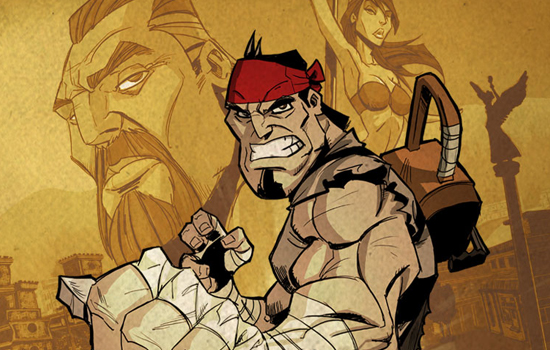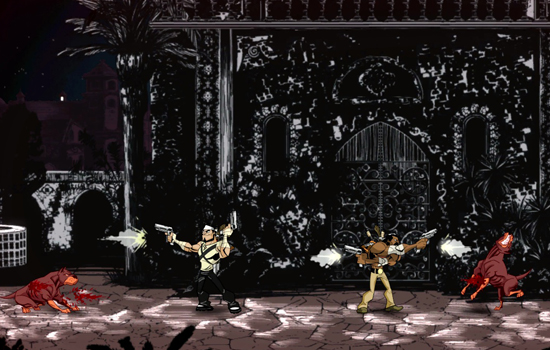

Shank is a game about a guy name Shank who shanks a lot of guys. It’s probably the most appropriate title for a game in recent memory. It is a story of revenge, mistaken identity and a whole lot of sticking sharp things into the soft parts of bad guys.
The first think you’ll notice is Shank’s presentation, which is outstanding. The art style feels an awful lot like Penny Arcade and a Robert Rodriguez movie got run through a blender. The animation is detailed, smooth, and the brutality of the combat is reflected quite nicely. Oftentimes during the story, you’ll get a picture-in-picture view of what the bad guys are up to, which is incredibly slick. Add in absolutely gorgeous background art, and you’ve got quite a visual treat.
Combat is fast, fun, varied and in a surprising twist, mostly based around crowd control. You are constantly swarmed by enemies and the key to survival is learning how to dodge and split groups of enemies up to land your attack combos. Especially important is Shank’s “pounce” ability (any game with a button labeled “pounce” is fine by me), which causes him to leap into the air and onto an enemy, knocking them to the floor and allowing him to do massive damage. It’s pretty fun to tackle a guy and tickle his torso with your chainsaw.
There’s an annoying problem with the combat, however. For whatever reason, the button to pick items up is mapped to your primary attack button, and picking up items takes priority over an attack, so if you fight anyone near a health item, you’ll pick it up, often when you’re still near full health. Additionally, you cannot pounce on a “large” enemy, but if enemies are in a group, the pounce move appears to randomly choose a target, often the guy you get punished for trying to land on.
It’s a little confusing that enemies seem to be made of resilient stuff. In a traditional beat-em-up title, it makes sense that your foes can take a few punches before going down, but in Shank you’re sticking chainsaws and katanas into a foe’s chest and twisting ‘em around. You’d think these would kill a normal man, but even your average grunt in this game can usually survive the ordeal. It’s almost as if their life bars are longer to keep the game from being shorter than it already is.
You will learn to absolutely HATE these dogs.
Bosses are frustrating and cheap, but once you learn their pattern, they’re criminally easy to defeat, except for the final boss, who is a royal pain in the butt. The traditional boss experience in Shank is to die once in an unexpected and/or lame manner, then not take any damage the second time through. Why is this? Well, the game flat out tells you the boss strategy once you die. It’s a nice feature to keep you moving, but it’s like the developers don’t trust you to figure out the mechanics on your own.
The co-op is local only, for beat-em-ups I don’t mind that, and for this game it’s quite convenient to have someone to punch close by. The co-op campaign is actually a prequel to the events of the single-player content, where Shank pairs up with his comrade Falcone to (naturally) shank more gang members. Though the gameplay largely stays the same, the addition of co-op moves mixes things up a bit. Shank’s mostly useless grapple move from the single-player mode becomes the key to co-op stabbination: huck an unwitting gang member at your partner and they can unleash some sweet carnage.
Unfortunately my two primary complaints about the single-player campaign are exacerbated in co-op mode. Health items are often placed in pairs, and anyone mashing their primary attack button might accidentally take both of them, leaving their partner in a bad situation. It’s really annoying, and in a game whose fighting mostly takes place on flat, 2D planes, it doesn’t really make sense to have to worry about positioning, especially with two players. The bosses are also a chore, and though they often have similar gimmicks to the ones in the single-player, they’re not always obvious.
Shank is a gorgeous game, and when it’s at its best, it’s a great experience. The co-op is just as flawed as the main campaign, but both are good for mindless (though slightly frustrating) fun. If you’ve got a buddy and a free afternoon, you’ll probably enjoy Shank.